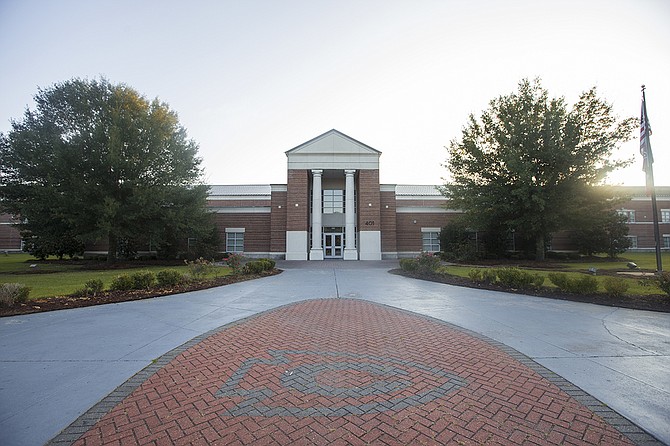The Clinton Public School District is the state’s highest-performing, majority-black school district in Mississippi; the district received an “A” grade in 2016. Photo by Imani Khayyam.
Recent Clinton High School graduate Tess Stanford says she, Bryce Little, Neil Paul and Normanda Brown spent the last 12 years of their lives together. They did sports and clubs and honors societies. Tess' mom taught Normanda in third grade.
In May, the high school seniors graduated from Clinton High School, the only high school in the Clinton Public School District in the small but bustling western suburb of Jackson. And for these seniors, there is not a better school—or district—in Mississippi to get an education.
"Turn on the TV—it's always about Clinton. It's always something good," Brown said. "You always see something in Jackson schools—someone got into a fight at school; the superintendent quit.
"In Clinton it's always something positive. I don't see why you wouldn't come here."
Paul says the district offers an education on par with the prestigious and private St. Andrew's Episcopal School in Ridgeland, which boasted seven students with perfect ACT scores at the last graduation. When his parents considered moving from Hinds County to neighboring Madison County, he did not even want to go.
Little says it is just different in Clinton than in the other high-performing suburban public high schools nearby, like Madison Central High School in wealthy Madison. "There's always that support to learn more," Little said.
"All your teachers are really challenging you."
Stanford agrees that Clinton has great teachers. But for all its excellence, she says, it is just like any other high school.
"There's drama, there's pettiness," she says. "... It's just like any typical high school, it's just Clinton. It's just like a small town. We're all like together more, and we've all grown up together. It's very community-based. Everyone knows everyone, and everyone knows everything about everyone."
'Intentional Integration'
Clinton High is unique in more than just its academic excellence.
The October 2016 release of Mississippi's accountability ratings for each public-school district reveals wide racial disparities. Each failing school district in Mississippi teaches a student population that is at least 80 percent black. Fifty percent of black students in Mississippi attend a district rated "D" or "F." Of schools rated "F," more than 95 percent of their students are black.
Mississippi Department of Education data reveal that at 28 points, the gap between white and black students is larger than any other achievement gap in the state, including between that of English speakers and English-language learners and between students with and without individual education programs or IEPs. The achievement gap between students who do and do not live in poverty is second highest in the state at 27 points.
But the Clinton Public School District—an apparent anomaly—presents a different narrative for black students. More than fifty-two percent of its students are black, and the district is rated an "A." This makes the district the highest-performing majority-black district in the state. Nearby Madison County School District and Rankin County School District are both "A" districts as well, but their black student populations are much lower than in Clinton. Madison's black student population is 39 percent, while only 22 percent of Rankin County's student population is black.
Clinton's ability to narrow these gaps is due, in part, to the district's intentional integration. And though Clinton is far from being a post-racial mecca, students and administrators say that effort has paid off.
There are no black schools or white schools in Clinton, and there is just one high school. In a district that is about 53 percent black and 39 percent white, children share the same resources, teachers, and the same well-stocked classrooms and school buildings, regardless of their race or economic status.
"Our school system doesn't have a neighborhood school of the haves and a neighborhood school of the have-nots," just-retired Clinton Superintendent Philip Burchfield said. "We always said if we start our kids off in Clinton, it makes no difference; we're going to give them the resources they need to be successful."
Not Bled Dry by White Flight
Dr. Philip Burchfield just completed his eighth and last year as superintendent of the Clinton Public School District. He retired this summer after nearly a decade of leading the district. During his tenure, the district drew the highest possible accountability rating from the state. Burchfield points to consistent community support and prioritizing students' needs as vital to Clinton's success model. But so is intentional equity.
The Hechinger Report reported in April 2016 that Clinton decided to organize schools by grade level instead of neighborhood in 1970 in order to comply with desegregation orders, prolific in Mississippi after the state largely resisted integration efforts for nearly two decades starting with the 1954 Brown v. Board of Education decision.
Partitioned from the Hinds County School District, Clinton included a majority-black neighborhood within its borders, with federal approval. And unlike Madison County, white families don't have other schools within the district to flee to at the tipping point. U.S. Census data show that Clinton and Madison both had populations at about 25,000 in 2010. But 34 percent of Clinton's residents are black, compared to just 10 percent of Madison's today.
The district's success is not based on sheer wealth, Burchfield emphasized.
"I'm not saying we have a ton of money out here in every household, and I'm not saying we're affluent out here, but we do the best we can with what we're given," Burchfield added. "I think if you call it a tipping point, what you're really saying is that all kids can't learn. And we have never in our district given a kid (or) allowed a kid to use an excuse because of the color of his skin that he can or cannot perform. It's obvious with the amount of accommodations that we make for kids. We work very hard to maintain that relationship with blacks and whites here. Transparency. It just works."
Clinton may not have the high-growth reputation of other suburbs of Jackson, Burchfield said, but the district has kept its eye on the educational ball for all students. "It's a great place to work. It was booming, but we probably took a little bit of a backseat as far as retail (compared to) Madison and Flowood, but our public schools have never wavered at all," he said.
"I'm telling you, this community is defined so much by its public schools."
Setting a High Bar
Although Clinton has seen great success, other school districts in less-affluent, rural areas of Mississippi still struggle with compliance with federal desegregation orders of the 1960s and 1970s. The Cleveland School District in Bolivar County in the Mississippi Delta made headlines last year when a federal ruling forced its middle and high schools to consolidate, to the chagrin of many of its citizens. More than 50 districts in Mississippi are still under federal desegregation orders.
Incoming Clinton Superintendent Tim Martin says the district is closing the achievement gap between black and white students with high standards, not only for administrative and teacher performance, but also for student success. He says the entire community of Clinton, from parents to educators, invests time and attention to make sure all students can succeed, regardless of their racial background.
"In my opinion, the way to close those gaps is not to focus specifically on the gap, but to make sure you have high standards and high expectations," Martin said. "You don't want to (close the gap) by having white students score less; you want your minority students to rise and score at the same level. It's not closed in one year; it's student by student, family by family working together to stay successful."
Clinton can also attribute its success to the relatively low number of students living in poverty. Although about 40 percent of students receive free and reduced-price lunch, the poverty level in the city is 15.5 percent. Statewide, the poverty level for children is nearly double that.
Superintendent Martin says the district doesn't receive a "huge amount" of Title I funding to support its low-income students, but funnels money it does get toward helping students in kindergarten through fifth grade, and on acquiring intervention teachers.
"If we can give them a sound foundation whether they are from poverty, if they get that foundation, the rest of their education will be successful," he said.
Richard Kahlenberg, a senior fellow at The Century Foundation who studies socio-economic integration in education, says it's "not at all surprising" that the only majority-black district in the state to receive an A grade is also economically integrated.
"African American students and low-income students can perform well if given the right environment, but too many low-income students of color are consigned to high-poverty, segregated schools that don't provide the ingredients necessary for success," he said.
"By taking steps to integrate its schools, Clinton is showing what is possible when all students are given access to strong, socioeconomically and racially integrated schools."
A 2016 fact sheet on the impact of integration on students by the nonprofit Century Foundation says that socioeconomically integrated schools provide students with a range of economic and social benefits beyond academics.
Attending a racially diverse school can result in a "dramatic decrease in discriminatory attitudes and prejudices" among students, it said.
Foundation fellow Kahlenberg noted that parental involvement tends to be "more robust" in wealthier schools, where parents may have more time and job flexibility to volunteer.
Not Perfect, Though
Nia Sims, now 21, graduated from Clinton High School in 2014. The lifelong honors student, now on the verge of her final year at Mississippi State University in Starkville, says she was not aware that her high school had a black majority while she was there.
Her AP classes, she says, were a mix of students of different racial, cultural and class backgrounds.
Sims herself is black; her parents both work in the medical field—her mother is a pediatrician, and her father is an epidemiologist. "It wasn't strange to have friends that weren't Christian or weren't middle class," she said. "It wasn't strange to have friends with parents who had high school degrees, who had GEDs, PhDs (and) master's degrees."
Clinton's integration efforts are not perfect, though. Despite its relative success, Clinton is still dealing with achievement gaps in some grade levels and subject areas. And though the district is more than half black, its teaching staff does not reflect that diversity, something Martin says the district is working on by making a dedicated effort to recruit from the state's historically black colleges and universities.
Sims, however, says her school principals were normally people of color.
"The majority of our school administrators were either black men or women," she said. "It wasn't strange at all to see a black person or woman of color in charge of us, which we didn't realize a lot of students really don't get."
In Clinton, current and former students say the district's reputation and ratings show it is doing something right.
The Jackson suburb will soon be home to one of three Continental Tire plant locations in the United States; the possibility of new jobs will most likely attract even more new people to the city.
And as Clinton has grown, so has the district's student body. High-school students take classes in trailers parked outside the building to accommodate the large population of kids. This issue will not be quickly resolved, given the state's cuts to the education budget.
But Martin has high expectations for Clinton's future.
"Future success, you can't rest on past success, but you can learn from the past and continue to do the things that made you successful," he said.
"We do not back down from any expectation. We want excellence in behavior, discipline, academics—in all areas of a child's education, we expect excellence," Martin said.
"We expect them to be the best they can be, regardless of sex or race or anything about them.
"Children deserve to be pushed and expected to achieve at their highest level," Maritn added.
Sierra Mannie is a freelance writer in Jackson. This story was produced by The Hechinger Report, a nonprofit, independent news organization focused on inequality and innovation in education.




